How to Foster Student-Led Learning: Part Three in Our Series on Shifts and Strategies for Teachers
“Young people with high levels of agency do not respond passively to their circumstances; they tend to seek meaning and act with purpose to achieve the conditions they desire in their own and others’ lives.” The Influence of Teaching (Ferguson et al, 2015)
We believe students learn deeply when learning experiences are designed to develop ownership over their own learning. Whether it’s focusing on areas of personal interest or having input over their learning experiences, fostering student-led learning supports the development of independence and self-direction, lifelong learning skills.
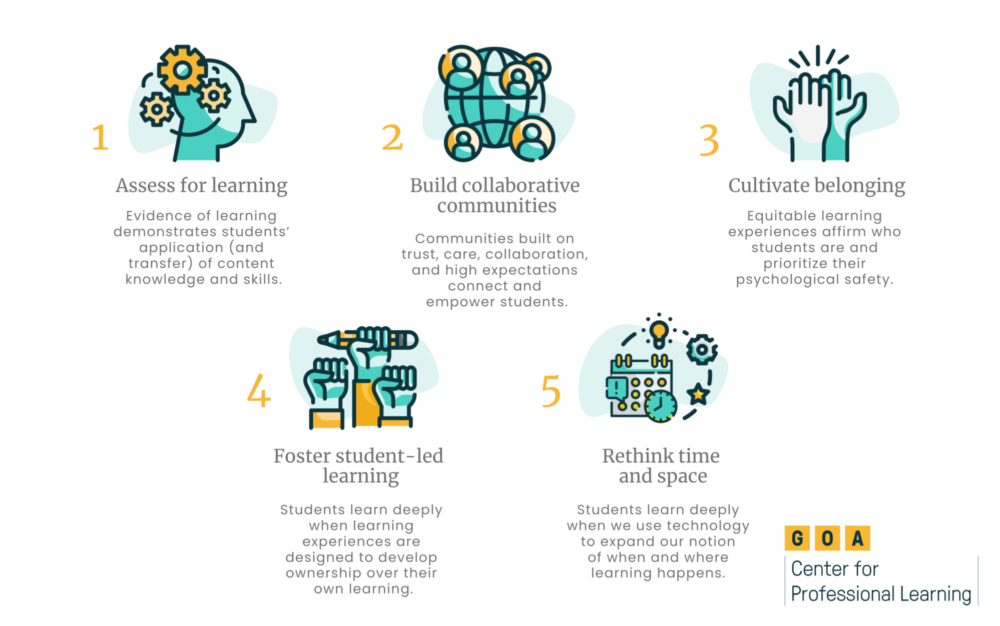
GOA's Educator Competencies
As the third blog post in a five-part series on GOA’s Educator Competencies, we aim to define what it looks like to foster student-led learning and offer considerations for actions educators can take.
What Students Say
Over the past two years, as educators, students, and families have adjusted and shifted between online, in-person, and hybrid learning, students are recognizing the importance of leading their own learning. Tami A., a junior at Providence Day School (NC) reflects on prioritizing agency in light of her experiences with remote learning: “Online learning and hybrid learning are all things that were not the ‘norm’ for most students but things all of us had to learn to adapt to. Allowing students to lead their own learning will allow them to make choices that are best suited for their personal learning style and schedule as well as allow them to take pride in their work and feel confident in sharing their newfound learning with others.”
Why does this matter? Alyssa T., a student at Kingswood Oxford School, said, “It is important for students to lead their own learning because it lets us take responsibility for our own learning, from which we can build the independence and skills we need to succeed in life….At my school, we have Harkness Discussions, which are student-led discussions on a book, or something that we are currently working on. They are amazing because they give the students the opportunity to share with each other their thoughts and opinions without being influenced by the teacher.”
As teachers, what are moves that we might make to foster student-led learning? Below we share specific examples and strategies of educator shifts as they support students in leading their own learning.
What This Looks Like
Playlists, Not Packets
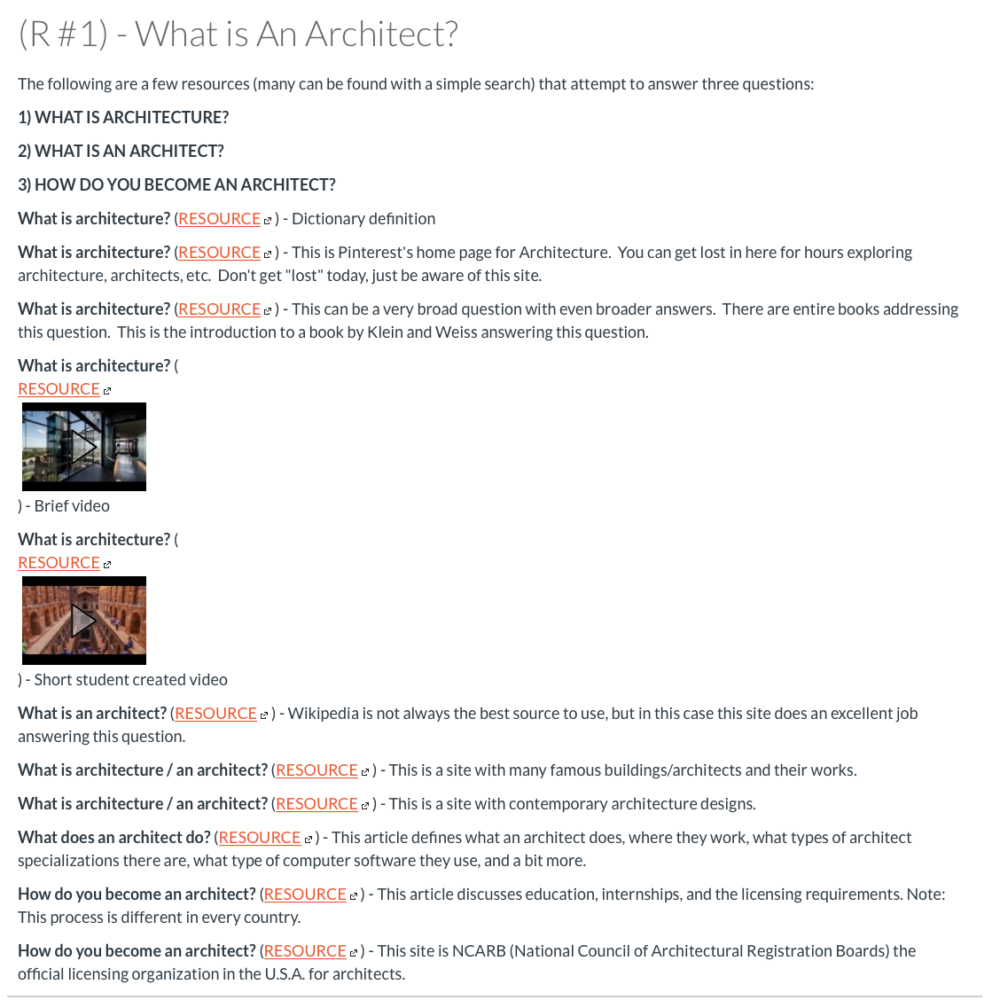
An example content playlist from GOA’s Architecture course.
In GOA courses, we provide students with a variety of options to engage. One strategy, “Playlist not packets,” provides students with a curated set of materials that invites students to make their own choices and launch their own inquiries. A mix of content including text and video helps students navigate their options. In the image above, from GOA’s Architecture course, students are invited to think about three questions: What is Architecture?, What is an Architect?, and How do you become an Architect?
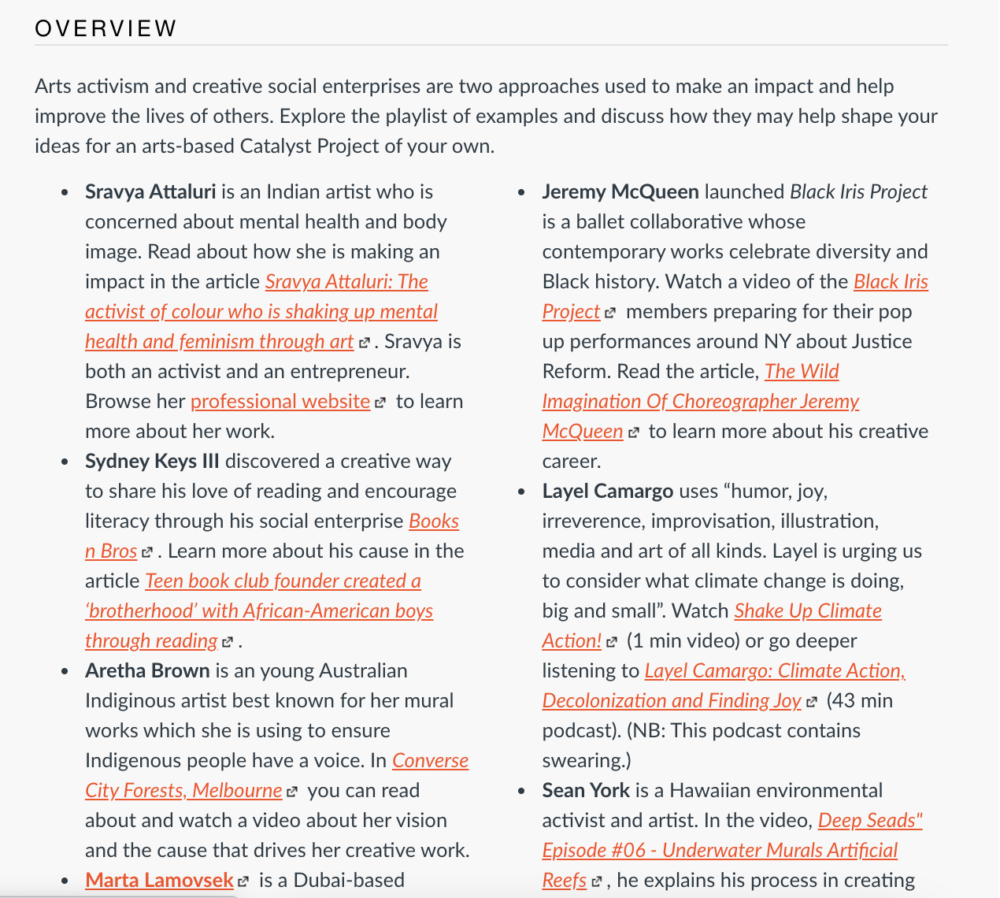
Playlists are also good strategies to balance dominant voices. Above is an example from GOA’s Arts Entrepreneurship course. Students are exploring arts activism and arts-based social enterprises. Thoughtful curation of content in playlists can help ensure a broader representation of voices of authority that is more inclusive, culturally, and gender-affirming. This task invites students to select from a wide range of examples, as well as having students contribute to a student playlist.
Choice Boards
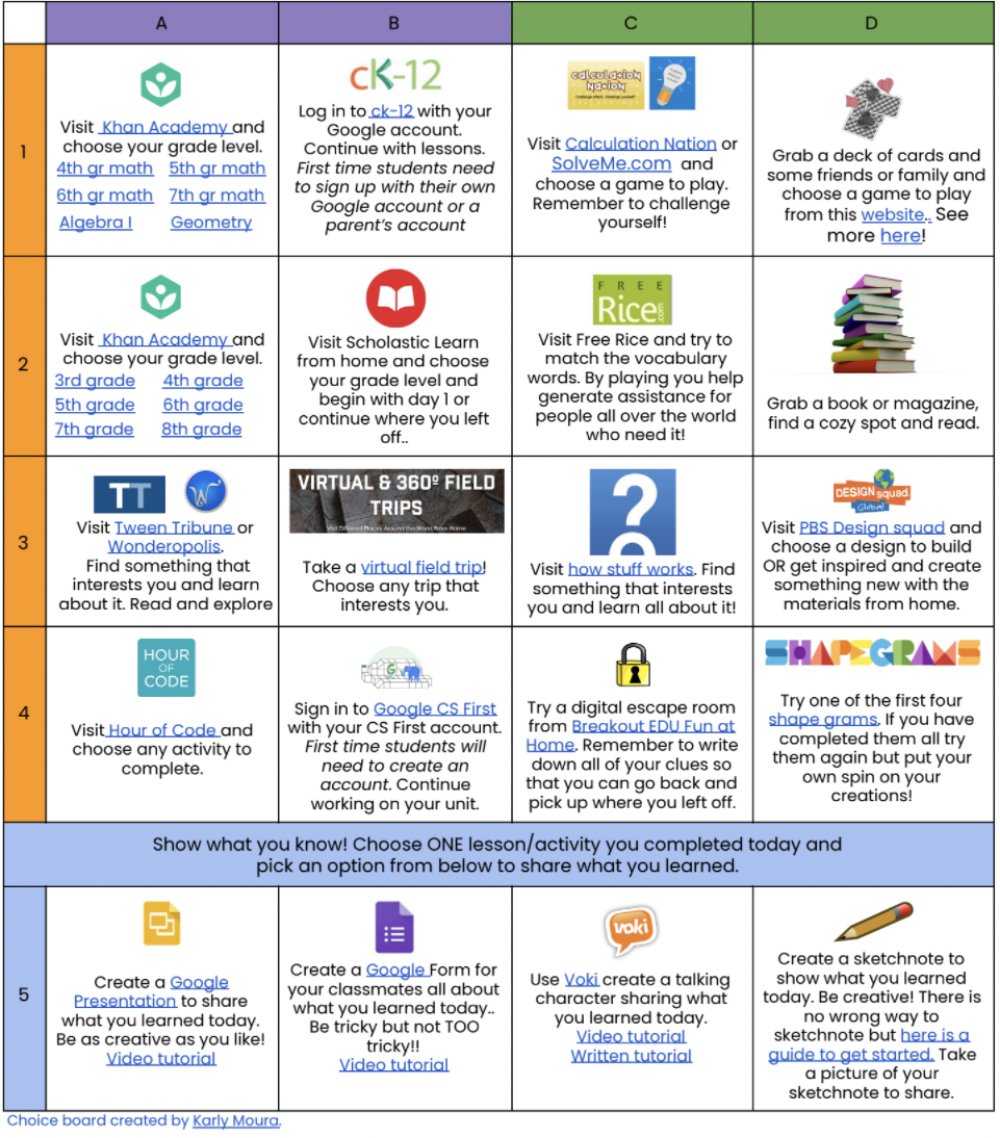
Choice boards are an example of how to structure choice that provides students agency within a menu provided by the teacher. Choice boards could be expanded to personalize and give students input into time allocation, pacing, and order of learning activities. The example above is from Karly Moura, a computer science and technology teacher, used during distance learning. Here, curation and forethought play a big part in creating conditions for student choice. The grid is laid out with various learning activities as well as the “show what you know” section. Karly provides parameters for students to work within. Students choose two activities from each row #1-4 with one activity from column A or B and one activity from column C or D. Finally they choose an activity from row #5 to show what they learned. Choice boards allow for some personalization and invite students to co-design by asking them to make decisions about how they’ll learn and how they’ll demonstrate their learning. Want to see a walk-through video of a Choice Board? Check out this short video we made.
Station Rotations
Having the “ability to make key decisions about their learning is a powerful motivator for students,” says professional learning leader Catlin Tucker. Based on a blended learning model, station rotations incorporate a variety of activities that include blending technology, face-to-face, and collaborative learning activities. Station rotations have students moving through activities such as small-group or full-class instruction, group projects, individual tutoring, and pencil-and-paper assignments. Caitlyn recommends infusing more student voice and choice into station rotations by inviting students to contribute to the what, the how, and the why, making them co-designers of their learning.
Skill Trees
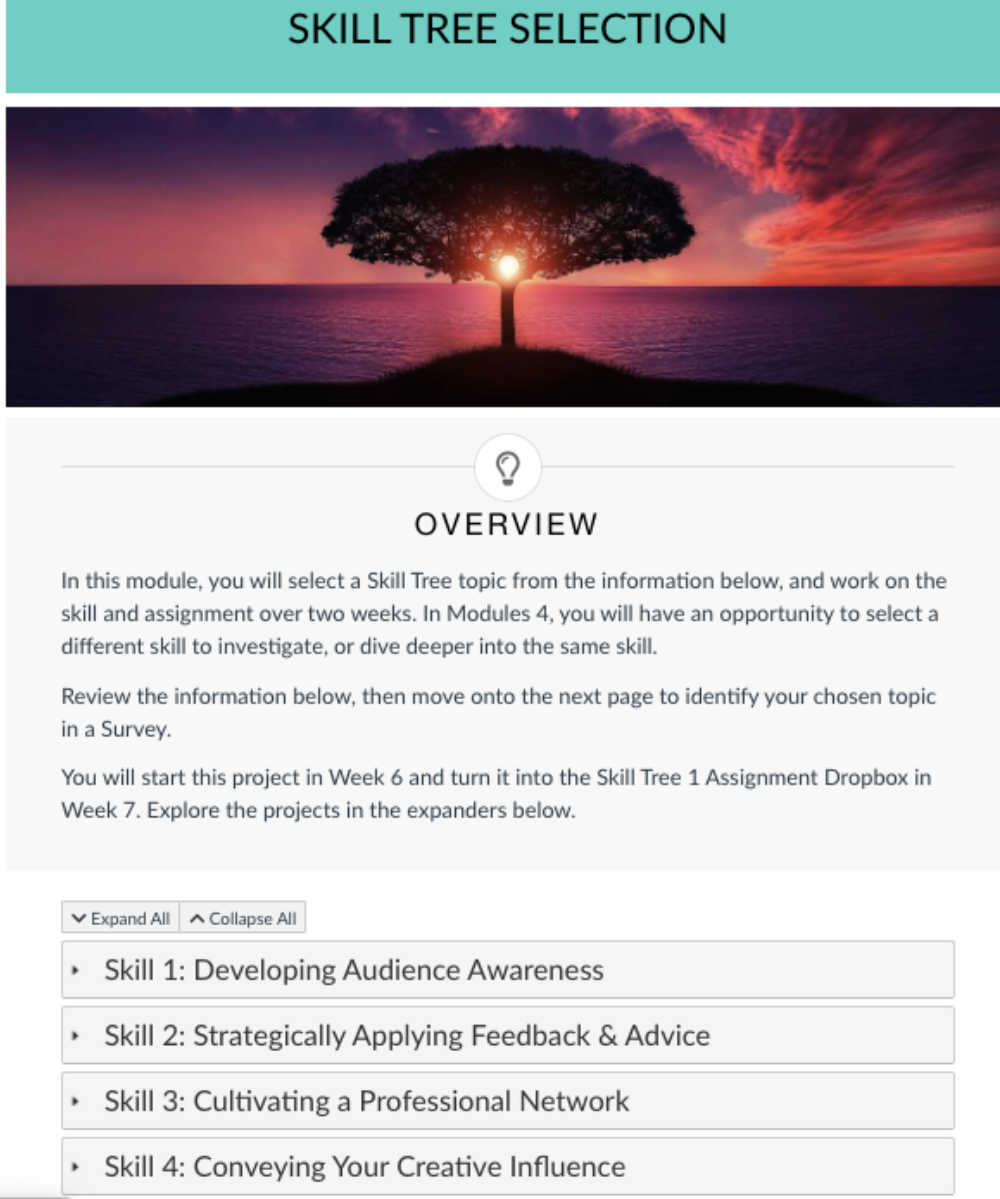
Some GOA courses design a Skill Tree for students to engage in skills at their individual levels. Students choose where they are and engage in activities to develop their skills along with their own personalized pacing. The example above shows a course in which students can choose which skill they want to develop and practice, with a corresponding assignment over two weeks. Later in the course, students have an opportunity to choose a different skill or dive deeper into the same skill.
Automated Quizzes
In an Aurora Institute blog post by Charmaine Mercer, Taking Time to Assess What Students Know, Think, and Feel, Mercer shared that "rich assessments, such as portfolios, projects, or extended performance tasks, provide students more opportunities to demonstrate depth of knowledge, while also assessing other skills, such as collaboration and communication." In GOA courses, personalized learning can lead to greater complexity and diversity in the work students produce. High-quality work has elements that are cognitively complex which is required for the transfer of learning.
Teachers and students use different tools and routines to help collect varied evidence of learning over time. For example, with strategies such as automated quizzes, students can test out or record progress when they are ready. This gives students instant feedback and can propel them forward--or guide them back to recheck, relearn or go deeper.
Conferencing
Conferencing is another powerful way to shift agency to students. Educators can have regular brief conferences with students where they tell you ‘Where I am at’?, ‘What’s next?’, and ‘How do you know how you’re going?’ These conferences can provide evidence of learning and build confidence quickly. Combined with public learning goals or checklists, these can become student-driven learning updates that don’t need significant amounts of time and can personalize the assessment process.
These shifts result in students who are empowered in ways that could have impacts beyond classrooms. Karthi R., a junior at Germantown Friends School (PA), said, “In my high school, all juniors have the month of January off to do an internship or explore career opportunities. I went to California and worked with a huge startup company that was created by alumni of my school. I got to do things that I thought I would never do in my high school years. It was overall an amazing time and experience. Teachers supported me by checking in every Tuesday and Friday to see how I was doing.”
Need additional ideas and inspiration? Here are a few articles that rise to the top of our playlist.
GOA serves students, teachers, and leaders and is comprised of member schools from around the world, including independent, international, charter, and public schools. Learn more about Becoming a Member. Our professional learning opportunities are open to any educator or school team. Follow us on LinkedIn and Twitter. To stay up to date on GOA learning opportunities, sign up for our newsletter.


